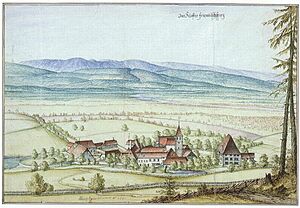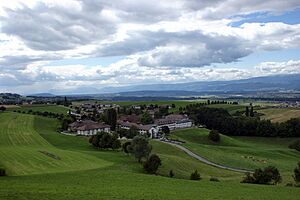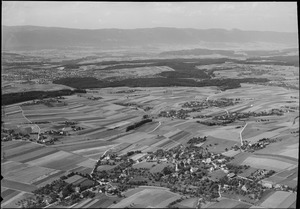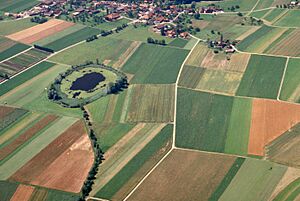Seedorf, Bern facts for kids
Quick facts for kids
Seedorf
|
||
|---|---|---|
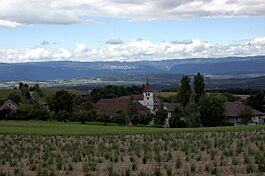
Frienisberg village in Seedorf municipality
|
||
|
||
| Country | Switzerland | |
| Canton | Bern | |
| District | Seeland | |
| Area | ||
| • Total | 20.87 km2 (8.06 sq mi) | |
| Elevation | 563 m (1,847 ft) | |
| Population
(Dec 2020 )
|
||
| • Total | 3,134 | |
| • Density | 150.17/km2 (388.93/sq mi) | |
| Postal code |
3267
|
|
| Localities | Lobsigen, Wiler, Frieswil, Baggwil, Ruchwil, Dampfwil, Aspi, Grissenberg, Frienisberg | |
| Surrounded by | Aarberg, Grossaffoltern, Lyss, Meikirch, Radelfingen, Schüpfen, Wohlen bei Bern | |
Seedorf is a town, also called a municipality, in Switzerland. It is located in the Seeland area of the canton of Bern.
Contents
Exploring Seedorf's Past
Seedorf was first mentioned in old writings between 1173 and 1180. It was called Sedorf back then.
Ancient Settlements in Seedorf
The land around Seedorf has been home to people for a very long time. The oldest known settlement is at Lobsigensee. It dates back to the late 4th millennium BC. This site is now a special UNESCO World Heritage Site.
Other ancient places found here include:
- A Hallstatt burial mound at Einschlag. A burial mound is a large pile of earth or stones over a grave.
- A La Tene skeleton found near the Seedorf school.
- Early and high medieval settlements near the church.
The Story of Frienisberg Abbey
Most of Seedorf belonged to Count Udelhard of Saugern a long time ago. In 1131, he gave his land to a group of monks. They later founded Frienisberg Abbey.
The monks, called Cistercians, came from Lützel Abbey in 1138. They built a new abbey at Frienisberg. At first, the abbey was small. It grew bigger in the early 1200s thanks to many gifts of land. By 1233, it owned land in several nearby villages.
In the late 1200s, the abbey started three nunneries (places for nuns). In 1267, Count Udelhard's family sold more land and rights in Seedorf to the Abbey.
Seedorf Church and Bern's Influence
The village church was first mentioned in 1131. By 1320, it became part of Frienisberg Abbey. In 1386, the Abbey became very close to Bern. Its monks and farmers became citizens of Bern.
This close link led to problems when Bern changed its religion. Bern became Protestant during the Protestant Reformation. Many monasteries, including Frienisberg, were closed down. The last abbot, Urs Hirsinger, left rather than stay in Bern.
In 1534, the abbey church was torn down. The old abbey building became a hospital in 1533. It then housed Bern's local governor, called a bailiff, until 1798. This bailiff managed the Frienisberg area, which included Seedorf.
Changes in Farming and Population
Around 1850, many farms in Seedorf changed. They started raising animals and making dairy products instead of just growing crops. But the Seedorfmoos swamps limited the land.
Between 1858 and 1957, the Seedorfmoos swamps were drained. This created more land for farming. Seedorf was on an old main road, but new roads and railways bypassed it. Because of this, Seedorf stayed focused on farming and small local businesses.
In the 1920s, farming became more modern. Fewer people were needed to work on farms. This caused the population to drop for almost 50 years. In the 1970s, the population started to grow again. People who worked in nearby cities moved to Seedorf.
Frienisberg Abbey Today
In 1834, the Abbey building was turned into a home for people who could not hear or speak. In 1889, it became a nursing home. It still serves as a nursing home today.
Seedorf's Landscape and Nature
Seedorf covers an area of about 20.84 square kilometers (8.05 square miles).
How Land is Used
- Almost 60% of Seedorf's land is used for farming. This includes fields for crops and pastures for animals.
- About 32.5% of the land is covered by forests.
- Around 7.7% of the land has buildings or roads on it.
- A small part, about 0.2%, is made up of rivers or lakes.
Where Seedorf is Located
The town of Seedorf is on the northern edge of the Frienisberg Plateau. This area is between 469 and 823 meters (1,539 and 2,700 feet) above sea level.
Seedorf includes several villages:
- Seedorf
- Aspi
- Baggwil
- Dampfwil
- Frienisberg
- Frieswil
- Lobsigen
- Ruchwil
- Wilerand
It also has eleven smaller settlements called hamlets and many scattered farmhouses.
Seedorf's Coat of Arms
The blazon (official description) of Seedorf's coat of arms is: "Per fess Argent and Azure in chief a Semi Bear rampant issuant Sable langued Gules."
This means the shield is divided into two parts horizontally. The top part is silver (Argent) and the bottom part is blue (Azure). In the top silver part, there is a black (Sable) bear standing on its hind legs (rampant), with a red (Gules) tongue (langued). Only the top half of the bear is shown (Semi Bear rampant issuant).
Who Lives in Seedorf?
Seedorf has a population of about 3,144 people (as of 2000).
Population Changes and Background
- In 2010, about 4.7% of the people living in Seedorf were foreign nationals.
- Over 10 years (2000-2010), the population grew by 2.4%.
- Most of this growth came from people moving into Seedorf (2.5%).
- Births and deaths accounted for a smaller change (0.9%).
Languages Spoken
Most people in Seedorf speak German.
- 96.6% speak German as their first language.
- 0.7% speak French.
- 0.5% speak Albanian.
- A small number of people also speak Italian.
Where People Come From
- About 34.9% of the people living in Seedorf in 2000 were born there.
- 43.1% were born in the same canton (Bern).
- 13.5% were born elsewhere in Switzerland.
- 6.1% were born outside Switzerland.
Age Groups
As of 2010:
- Children and teenagers (0–19 years old) make up 20.6% of the population.
- Adults (20–64 years old) make up 63.4%.
- Seniors (over 64 years old) make up 16%.
Historical Population Growth
The chart below shows how Seedorf's population has changed over many years.

Seedorf's Economy and Jobs
In 2011, Seedorf had a very low unemployment rate of 0.71%. This means almost everyone who wanted a job had one.
Types of Jobs in Seedorf
As of 2008, there were 1,199 people working in Seedorf. Jobs are often grouped into three main types:
- Primary Sector: This includes jobs that get raw materials from nature. In Seedorf, 236 people worked in this sector. This means jobs like farming and forestry. There were 73 businesses in this area.
- Secondary Sector: These jobs turn raw materials into finished products. In Seedorf, 216 people worked in this sector. This includes manufacturing (making things) and construction (building things). There were 36 businesses here.
- Tertiary Sector: These jobs provide services to people. In Seedorf, 747 people worked in this sector. This includes jobs in shops, hospitals, schools, and transportation. There were 72 businesses in this sector.
Working and Commuting
In 2000, 382 workers came into Seedorf for their jobs. However, 1,066 workers left Seedorf to work in other towns. This means more people from Seedorf work outside the town than people from outside work in Seedorf.
Most people get to work by private car (57.4%). About 13.9% use public transportation like buses or trains.
Religion in Seedorf
Based on the 2000 census:
- About 81.5% of the people belonged to the Swiss Reformed Church (a Protestant church).
- About 6.7% were Roman Catholic.
- About 7.41% belonged to other Christian churches.
- About 1.59% were Islamic.
- A small number were Orthodox Christian or Hindu.
- About 3.69% said they had no religion or were agnostic or atheist.
Learning and Schools in Seedorf
Education is very important in Seedorf.
Education Levels
- About 40.6% of people in Seedorf have finished non-mandatory upper secondary education. This is like high school after the required years.
- About 11.7% have completed higher education. This means they went to a university or a specialized college (a Fachhochschule).
The School System in Bern
The Canton of Bern has a specific school system:
- One year of non-required Kindergarten.
- Six years of Primary school.
- Three years of required lower Secondary school. Here, students are grouped by their abilities.
- After lower Secondary, students can continue their schooling or start an apprenticeship (learning a trade on the job).
Students in Seedorf Schools
During the 2009-2010 school year, 252 students attended schools in Seedorf.
- There were 3 kindergarten classes with 49 students.
- There were 11 primary classes with 163 students.
- There were 3 lower secondary classes with 40 students.
In 2000, 12 students came to Seedorf schools from other towns. However, 173 students from Seedorf went to schools outside the municipality.
Seedorf's World Heritage Site
Seedorf is home to a special place called the Lobsigensee prehistoric pile-dwelling settlement. This site is part of the Prehistoric Pile dwellings around the Alps, which is a UNESCO World Heritage Site.
What is a World Heritage Site?
A World Heritage Site is a place chosen by UNESCO for its special cultural or natural importance. These sites are protected so they can be enjoyed by people for many years to come.
The Lobsigensee Site
The Lobsigensee site is located on the southwestern shore of the lake of the same name. It is a very old settlement that dates back to the second half of the 4th millennium BC. This means it is over 5,500 years old!
People first started digging at the site in 1908. More test digs happened in 1924 and 1953. In the 1950s, private collectors found many old items there.
More recently, in 2005 and 2007, the site was explored again. These newer digs found a burnt layer, which suggests that at least one of the settlements was destroyed by a fire long ago. The 2005 tests also found signs of many old huts or houses.
See also
 In Spanish: Seedorf (Berna) para niños
In Spanish: Seedorf (Berna) para niños





